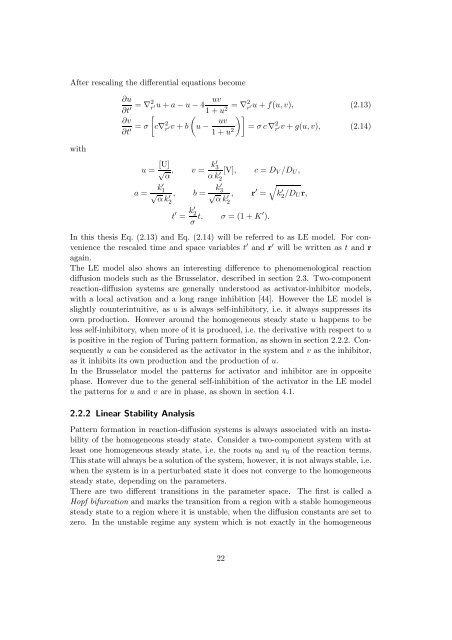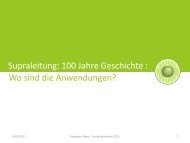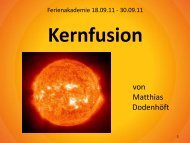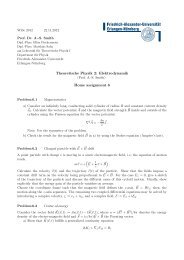Morphology of Experimental and Simulated Turing Patterns
Morphology of Experimental and Simulated Turing Patterns
Morphology of Experimental and Simulated Turing Patterns
You also want an ePaper? Increase the reach of your titles
YUMPU automatically turns print PDFs into web optimized ePapers that Google loves.
After rescaling the differential equations becomewith∂u∂t ′ = ∇ 2 uvr ′u + a − u − 41 + u 2 = ∇2 r ′u + f(u,v), (2.13)(∂v∂t ′ = σ[c∇ 2 r ′v + b u −uv )]1 + u 2 = σ c ∇ 2 r ′v + g(u,v), (2.14)u = √ [U] , v = k′ 3α αk 2′ [V], c = D V /D U ,a = k′ 1√ αk′, b = k′ 3√2 α k′, r ′ =2t ′ = k′ 2σ t, σ = (1 + K′ ).√k ′ 2 /D Ur,In this thesis Eq. (2.13) <strong>and</strong> Eq. (2.14) will be referred to as LE model. For conveniencethe rescaled time <strong>and</strong> space variables t ′ <strong>and</strong> r ′ will be written as t <strong>and</strong> ragain.The LE model also shows an interesting difference to phenomenological reactiondiffusion models such as the Brusselator, described in section 2.3. Two-componentreaction-diffusion systems are generally understood as activator-inhibitor models,with a local activation <strong>and</strong> a long range inhibition [44]. However the LE model isslightly counterintuitive, as u is always self-inhibitory, i.e. it always suppresses itsown production. However around the homogeneous steady state u happens to beless self-inhibitory, when more <strong>of</strong> it is produced, i.e. the derivative with respect to uis positive in the region <strong>of</strong> <strong>Turing</strong> pattern formation, as shown in section 2.2.2. Consequentlyu can be considered as the activator in the system <strong>and</strong> v as the inhibitor,as it inhibits its own production <strong>and</strong> the production <strong>of</strong> u.In the Brusselator model the patterns for activator <strong>and</strong> inhibitor are in oppositephase. However due to the general self-inhibition <strong>of</strong> the activator in the LE modelthe patterns for u <strong>and</strong> v are in phase, as shown in section 4.1.2.2.2 Linear Stability AnalysisPattern formation in reaction-diffusion systems is always associated with an instability<strong>of</strong> the homogeneous steady state. Consider a two-component system with atleast one homogeneous steady state, i.e. the roots u 0 <strong>and</strong> v 0 <strong>of</strong> the reaction terms.This state will always be a solution <strong>of</strong> the system, however, it is not always stable, i.e.when the system is in a perturbated state it does not converge to the homogeneoussteady state, depending on the parameters.There are two different transitions in the parameter space. The first is called aHopf bifurcation <strong>and</strong> marks the transition from a region with a stable homogeneoussteady state to a region where it is unstable, when the diffusion constants are set tozero. In the unstable regime any system which is not exactly in the homogeneous22






